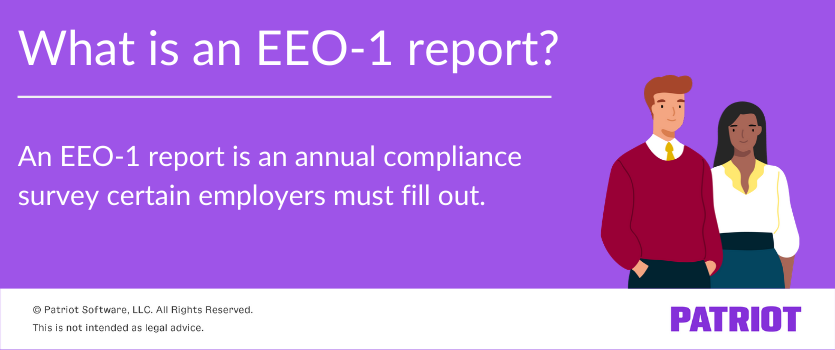When your business grows, you may need to hire additional employees. But, hiring more employees comes with additional responsibilities. Depending on the number of employees you have and some other factors, you may be responsible for filing an EEO-1 report. So … what is EEO-1, anyways?
What is an EEO-1 report?
An EEO-1 report (equal employment opportunity) is an annual compliance survey certain employers must fill out. The EEO-1 report is also known as a Standard Form 100. Qualifying employers file it with the Equal Employment Opportunity Commission (EEOC). The survey provides a demographic breakdown of the employer’s workforce and requires company employment data broken down by:
- Race/ethnicity
- Gender
- Job category
Title VII of the Civil Rights Act of 1967 mandates the EEO-1 report. The act requires certain employers to report the racial/ethnic and gender composition of their workforce (referred to as component 1 data). All employers in public and private sectors with 15 or more employees have to comply with Title VII of the Civil Rights Act of 1964 to be considered an equal opportunity employer. However, just because an employer must comply with Title VII of the Civil Rights Act of 1964 doesn’t mean they need to file an EEO-1 report.

Who needs to file an EEO report?
You must file an EEO-1 report if you are a private employer who is:
- Subject to Title VII of the Civil Rights Act of 1964 (as amended by the Equal Employment Opportunity Act of 1972) and has 100 or more employees (excluding state and local governments, public primary and secondary school systems, institutions of higher education, American Indian or Alaska Native tribes, and tax-exempt private membership clubs other than labor organizations) OR
- Subject to Title VII and has fewer than 100 employees but is owned, affiliated with, or controlled by a company with more than 100 employees overall
All federal contractors (private employers) must also fill out an equal employment opportunity compliance report if they have:
- 50 or more employees AND
- Are prime contractors or first-tier subcontractors, and have a federal government contract, subcontract, or purchase order amounting to $50,000 or more OR
- Serve as a depository of government funds in any amount OR
- Act as an issuing and paying agent for U.S. Savings Bonds and Savings Notes
Employers only need to fill out Standard Form 100 if the business or organization is located in the 50 states or District of Columbia (D.C.).
Who is excluded?
You may be wondering, What organizations or employers don’t have to file an EEO-1 report? Good question…
Federal contractors with 1 – 49 employees and other private employers with 1 – 99 employees are not required to file EEO-1 data.
Additionally, if you have 50 or more employees but you are exempt under regulation 41 CFR 60-1.5, you don’t have to file an EEO-1 report.
What does an EEO-1 form include?
List all employees in your EEO-1 report. This includes both part-time and full-time employees.
Input the following information on your EEO-1 report:
- Number of reports being filed by the company
- Company information (e.g., business name, address, etc.)
- Employer Identification Number (EIN)
- Total employees for each job category, gender, and race/ethnicity
- Previous year’s total
- Date of payroll periods used (October – December)
- The date and your title and signature
- Your contact information (e.g., email and phone number)
On your form, organize employee data by listing all employees by location (if applicable), job category, race/ethnicity, and gender.
Also indicate whether your business is a single- or multi-establishment employer. If you’re a multi-establishment employer, also submit these types of EEO-1 data reports:
- Consolidated Report (Type 2): All employees of the company categorized by race, gender, and job category.
- Headquarters Report (Type 3): Employees working at the main office site of the company and those employees who work from home and report to the corporate office. A separate EEO-1 report for the headquarters establishment is required even if there are fewer than 50 employees working at the headquarters establishment.
- Establishment Report (Type 4): A separate EEO-1 Type 4 report must be submitted for each physical establishment with 50 or more employees.
Multi-establishment employers with fewer than 50 employees must submit one of the following:
- Establishment List (Type 6): The establishment name, complete address, and total number of employees for each physical location where fewer than 50 employees are working.
- Establishment Report (Type 8): Submit a separate EEO-1 report for each establishment employing fewer than 50 employees.
How do you file an EEO-1 report?
After you fill out and review your EEO-1 report, it’s time to submit it to the EEOC.
You can either file your form online through the EEO-1 Online Filing System or complete a paper report. However, the EEOC prefers that employers utilize the online filing application system. If you want to file using a paper report, you must submit a request and get approval by calling the EEOC at 1-866-286-6440.
If you’re filling out your EEO-1 report online, do not forget to click the “certify report” button. If you do not click this button, the EEOC Employer Data Team will not receive your EEO-1 report.
What is the deadline for EEO-1 reporting?
EEO compliance reports must include information from a workforce snapshot period. This period is any pay period from October, November, and December of the current survey year. When counting employees for the period, only include employees on payroll during the workforce snapshot period.
EEO-1 reports are due by March 31 of the following year. For example, if your snapshot period is October 2020 – December 2020, your due date for your EEO-1 information would be March 31, 2021.
COVID-19 deadline
In light of the coronavirus pandemic, the EEO-1 deadline for 2020 was pushed back. The EEOC will not collect 2019 data until 2021. This means that employers’ EEO reports for both 2019 and 2020 are due March 31, 2021.
Steps for filing an EEO-1 report
To streamline the process of filing an EEO-1 report, follow the steps below:
- Determine whether you need to file a report
- Register as a first-time filer online through the EEOC’s website (if applicable)
- Collect information for your EEO-1 report (e.g., job classifications)
- Fill out your EEO-1 form
- Submit your completed report to the EEOC by the deadline
- Keep a copy of your annual EEO-1 form in your records for at least one year
To ensure you stay compliant, keep up with reporting requirements and deadlines. Failing to stay up-to-date with EEO-1 rules and filing an incomplete or inaccurate report can result in fines and other consequences for your business.
Contact the EEOC with any questions about the EEO-1 reporting process.
Want to make EEO-1 reporting even easier? With Patriot’s HR software, you can track employee demographic information and run a Demographics Report to get the data you need to enter on the EEO-1 report. Start your free trial and experience our payroll software and HR software add-on today!
Have questions, comments, or concerns about this post? Like us on Facebook, and let’s get talking!
This article has been updated from its original publication date of February 23, 2015.
This is not intended as legal advice; for more information, please click here.
